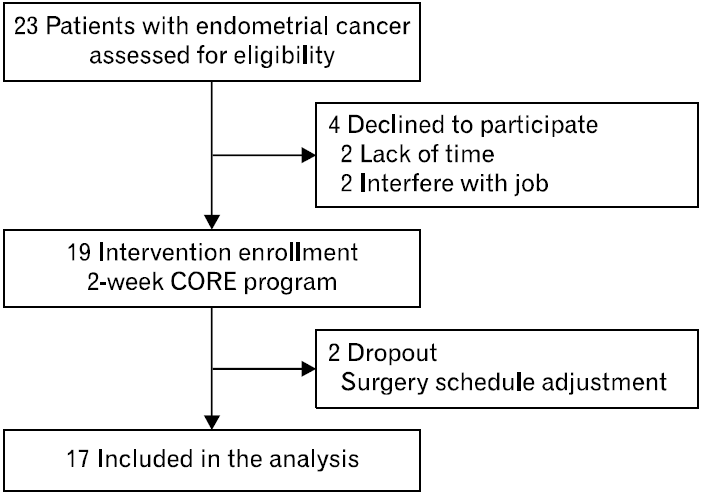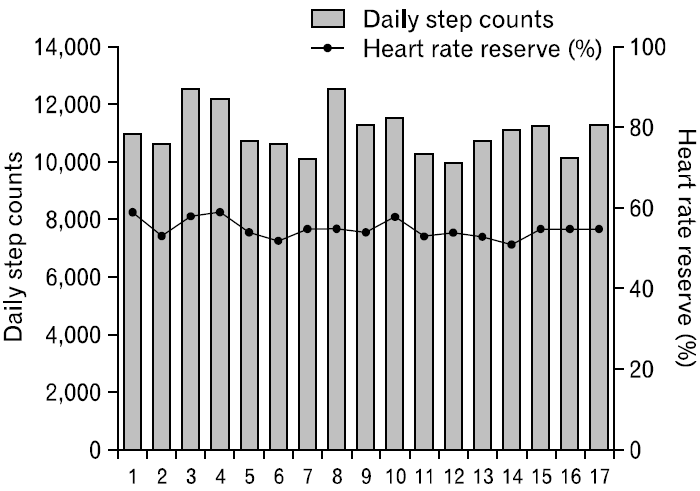1. Shin HR, Won YJ, Jung KW, et al. 2005; Nationwide cancer incidence in Korea, 1999-2001; first result using the national cancer incidence database. Cancer Res Treat. 37:325–31. DOI:
10.4143/crt.2005.37.6.325. PMID:
19956367. PMCID:
PMC2785938.

3. Office of Disease Prevention and Health Promotion. 2018. 2018 Physical Activity Guidelines Advisory Committee: Physical Activity Guidelines Advisory Committee Scientific Report. US Department of Health and Human Services;Washington (DC):
4. Du M, Kraft P, Eliassen AH, Giovannucci E, Hankinson SE, De Vivo I. 2014; Physical activity and risk of endometrial adenocarcinoma in the Nurses' Health Study. Int J Cancer. 134:2707–16. DOI:
10.1002/ijc.28599. PMID:
24213924. PMCID:
PMC3960316.

5. Moore SC, Lee IM, Weiderpass E, et al. 2016; Association of leisure-time physical activity with risk of 26 types of cancer in 1.44 million adults. JAMA Intern Med. 176:816–25. DOI:
10.1001/jamainternmed.2016.1548. PMID:
27183032. PMCID:
PMC5812009.

6. Dronkers JJ, Chorus AM, van Meeteren NL, Hopman-Rock M. 2013; The association of pre-operative physical fitness and physical activity with outcome after scheduled major abdominal surgery. Anaesthesia. 68:67–73. DOI:
10.1111/anae.12066. PMID:
23121372.

7. Lim MC, Won YJ, Lim J, et al. 2018; Second primary colorectal cancer among endometrial cancer survivor: shared etiology and treatment sequelae. J Cancer Res Clin Oncol. 144:845–54. DOI:
10.1007/s00432-018-2599-3. PMID:
29445866. PMCID:
PMC5916981.

8. Snowden CP, Prentis JM, Anderson HL, et al. 2010; Submaximal cardiopulmonary exercise testing predicts complications and hospital length of stay in patients undergoing major elective surgery. Ann Surg. 251:535–41. DOI:
10.1097/SLA.0b013e3181cf811d. PMID:
20134313.

9. Wilson RJ, Davies S, Yates D, Redman J, Stone M. 2010; Impaired functional capacity is associated with all-cause mortality after major elective intra-abdominal surgery. Br J Anaesth. 105:297–303. DOI:
10.1093/bja/aeq128. PMID:
20573634.

10. Silver JK, Baima J, Mayer RS. 2013; Impairment-driven cancer rehabilitation: an essential component of quality care and survivorship. CA Cancer J Clin. 63:295–317. DOI:
10.3322/caac.21186. PMID:
23856764.

11. American College of Sports Medicine. 2014. ACSM's health-related physical fitness assessment manual. 4th ed. Lippincott Williams & Wilkins;Philadelphia (PA):
12. Roberts HC, Denison HJ, Martin HJ, et al. 2011; A review of the measurement of grip strength in clinical and epidemiological studies: towards a standardised approach. Age Ageing. 40:423–9. DOI:
10.1093/ageing/afr051. PMID:
21624928.

14. Fayers PM, Aaronson NK, Bjordal K, Groenvold M, Curran D, Bottomley A. 2001. EORTC QLQ-C30 scoring manual. 3rd ed. EORTC Quality of Life Group;Brussels:
17. Armstrong T, Bull F. 2006; Development of the world health organization global physical activity questionnaire (GPAQ). J Public Health. 14:66–70. DOI:
10.1007/s10389-006-0024-x.

18. McTiernan A, Friedenreich CM, Katzmarzyk PT, et al. 2019; Physical activity in cancer prevention and survival: a systematic review. Med Sci Sports Exerc. 51:1252–61. DOI:
10.1249/MSS.0000000000001937. PMID:
31095082. PMCID:
PMC6527123.

19. Coats V, Maltais F, Simard S, et al. 2013; Feasibility and effectiveness of a home-based exercise training program before lung resection surgery. Can Respir J. 20:e10–6. DOI:
10.1155/2013/291059. PMID:
23616972. PMCID:
PMC3630051.

20. Dunne DF, Jack S, Jones RP, et al. 2016; Randomized clinical trial of prehabilitation before planned liver resection. Br J Surg. 103:504–12. DOI:
10.1002/bjs.10096. PMID:
26864728.

21. Moore SC, Gierach GL, Schatzkin A, Matthews CE. 2010; Physical activity, sedentary behaviours, and the prevention of endometrial cancer. Br J Cancer. 103:933–8. DOI:
10.1038/sj.bjc.6605902. PMID:
20877336. PMCID:
PMC2965881.

22. Dieli-Conwright CM, Ma H, Lacey JV Jr, et al. 2013; Long-term and baseline recreational physical activity and risk of endometrial cancer: the California Teachers Study. Br J Cancer. 109:761–8. DOI:
10.1038/bjc.2013.61. PMID:
23860525. PMCID:
PMC3738142.

23. Galvao DA, Taaffe DR, Spry N, Joseph D, Newton RU. 2009; Cardiovascular and metabolic complications during androgen deprivation: exercise as a potential countermeasure. Prostate Cancer Prostatic Dis. 12:233–40. DOI:
10.1038/pcan.2009.12. PMID:
19488067.

24. Peel AB, Barlow CE, Leonard D, DeFina LF, Jones LW, Lakoski SG. 2015; Cardiorespiratory fitness in survivors of cervical, endometrial, and ovarian cancers: the Cooper Center Longitudinal Study. Gynecol Oncol. 138:394–7. DOI:
10.1016/j.ygyno.2015.05.027. PMID:
26026734.

25. West MA, Loughney L, Lythgoe D, et al. 2015; Effect of prehabilitation on objectively measured physical fitness after neoadjuvant treatment in preoperative rectal cancer patients: a blinded interventional pilot study. Br J Anaesth. 114:244–51. DOI:
10.1093/bja/aeu318. PMID:
25274049.
26. Benzo R, Wigle D, Novotny P, et al. 2011; Preoperative pulmonary rehabilitation before lung cancer resection: results from two randomized studies. Lung Cancer. 74:441–5. DOI:
10.1016/j.lungcan.2011.05.011. PMID:
21663994. PMCID:
PMC3191236.

27. Jensen BT, Laustsen S, Jensen JB, Borre M, Petersen AK. 2016; Exercise-based pre-habilitation is feasible and effective in radical cystectomy pathways-secondary results from a randomized controlled trial. Support Care Cancer. 24:3325–31. DOI:
10.1007/s00520-016-3140-3. PMID:
26961741.

28. Chen BP, Awasthi R, Sweet SN, et al. 2017; Four-week prehabilitation program is sufficient to modify exercise behaviors and improve preoperative functional walking capacity in patients with colorectal cancer. Support Care Cancer. 25:33–40. DOI:
10.1007/s00520-016-3379-8. PMID:
27539131.

29. Mishra SI, Scherer RW, Snyder C, Geigle P, Gotay C. 2014; Are exercise programs effective for improving health-related quality of life among cancer survivors? A systematic review and meta-analysis. Oncol Nurs Forum. 41:E326–42. DOI:
10.1188/14.ONF.E326-E342. PMID:
25355029. PMCID:
PMC4332787.

30. Burke SM, Brunet J, Sabiston CM, Jack S, Grocott MP, West MA. 2013; Patients' perceptions of quality of life during active treatment for locally advanced rectal cancer: the importance of preoperative exercise. Support Care Cancer. 21:3345–53. DOI:
10.1007/s00520-013-1908-2. PMID:
23912669.





 PDF
PDF Citation
Citation Print
Print





 XML Download
XML Download